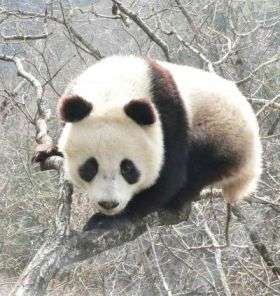Giant panda gut bacteria can't efficiently digest bamboo

It's no wonder that giant pandas are always chewing and eating, say Chinese researchers: their gut bacteria are not the type for efficiently digesting bamboo.
The bamboo-eating giant panda actually harbors a carnivore-like gut microbiota predominated by bacteria such as Escherichia/Shigella and Streptococcus, according to new research published this week in mBio, the online open-access journal of the American Society for Microbiology.
"Unlike other plant-eating animals that have successfully evolved, anatomically specialized digestive systems to efficiently deconstruct fibrous plant matter, the giant panda still retains a gastrointestinal tract typical of carnivores," said lead study author Zhihe Zhang, director of the Chengdu Research Base of Giant Panda Breeding, China. "The animals also do not have the genes for plant-digesting enzymes in their own genome. This combined scenario may have increased their risk for extinction."
"This result is unexpected and quite interesting, because it implies the giant panda's gut microbiota may not have well adapted to its unique diet, and places pandas at an evolutionary dilemma," said study coauthor Xiaoyan Pang, PhD, MSc, an associate professor in the School of Life Sciences and Biotechnology at Shanghai Jiao Tong University.
Giant pandas evolved from bears that ate both plants and meat, researchers said, and started eating bamboo exclusively about two million years ago. The animals spend up to 14 hours daily consuming up to 12.5 kg (27.5 pounds) of bamboo leaves and stems but can digest only about 17 percent of it; their feces is mainly composed of undigested bamboo fragments. Researchers had been intrigued by how the animals digest bamboo fiber and extract nutrients from it, Pang said.
To evaluate the panda gut microbiota, Pang and colleagues used a laboratory technique called 16S rRNA sequencing. They performed the technique on 121 fecal samples from 45 giant pandas (24 adults, 16 juveniles and five unweaned cubs) living in Zhang's Research Base. Samples were obtained during the spring, summer and late autumn of one year. Juvenile and adult pandas ate at least 10 kg (22 pounds) of bamboo and bamboo shoots each day, and 500 to 800 grams (1.1 to 1.7 pounds) of steamed bread. Total fecal weight was 10-15 kg (22 to 33 pounds) per day. The cubs had just fresh milk from their mothers.
The investigators found that despite their diet, these giant pandas, together with nine captive and seven wild individuals investigated previously, showed extremely low gut microbiota diversity and an overall structure that diverged from non-panda plant-eaters but was similar to carnivorous and omnivorous bears. The giant panda gut did not harbor plant-degrading bacteria such as Ruminococcaceae and Bacteroides that are typically enriched in other herbivores, but instead was predominated by Escherichia/Shigella and Streptococcus.
Panda gut microbiota also varied by season, with late autumn being quite different from spring and summer. The lack of bamboo shoots in late autumn could be an important factor, Pang said.The research team is planning a follow-up study combining different scientific techniques to more fully understand the function of the panda's gut microbiota on the animals' nutrition and health.
Journal information: mBio
Provided by American Society for Microbiology





















